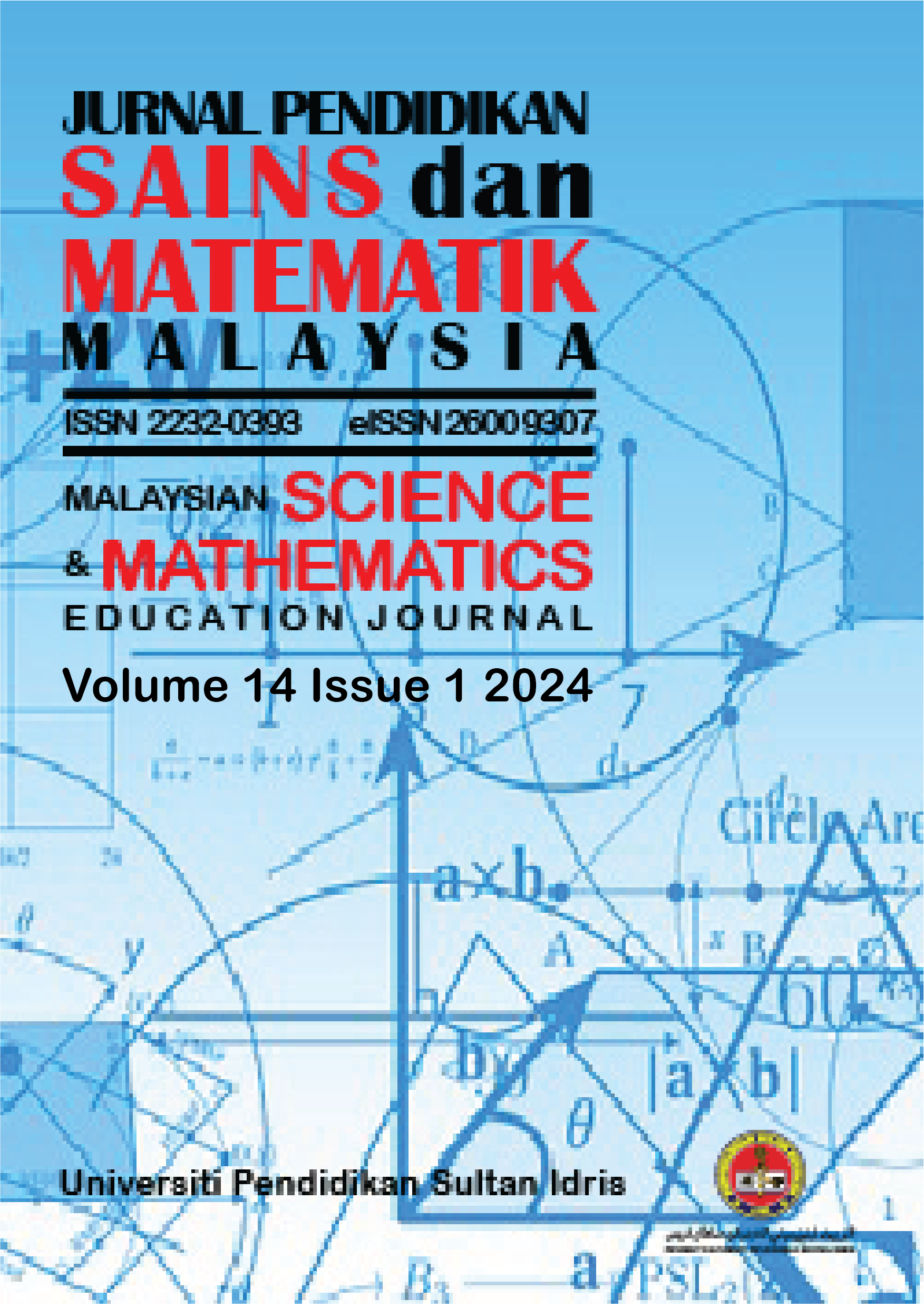Need Analysis for Development of Technology-Based Pedagogical Module for 3D Geometry: A Case Study in Malaysia
DOI:
https://doi.org/10.37134/jpsmm.vol14.1.7.2024Keywords:
3D geometry, technology, visual spatial skills, Mathematics, pedagogical module, teachersAbstract
The poor achievement of students in Mathematics, especially in 3D Geometry is due to their low Visual Spatial Skills. Relative research shows that a variety of teaching methods including hands-on activities with the application of technology can help to improve Visual Spatial Skills. Therefore, teachers need complete guidelines of suitable activities and technologies to be applied in their teachings. The purpose of this study is to identify the need for the development of a technology-based 3D Geometry pedagogical module to improve students' skills based on teachers' perceptions. This study applied a review method and used a questionnaire as the study instrument. The study sample consisted of 74 secondary school Mathematics teachers serving in Sarawak. In addition, the results show that there is a significant difference in performance expectancy and effort expectancy between teachers who served less than 15 years and more than 15 years. The mean score for these two of expectancies also shows a very high interpretation. Therefore, a teaching module for 3D should be designed to increase students’ performance in Geometry.
Downloads
References
Abdullah, A. H., Wahab, R. A., Mokhtar, M., Atan, N. A., Halim, N. D. A., Surif, J., . . . Rahman, S. N. S. A. (2022). DOES sketchup make improve students' visual-spatial skills? IEEE Access, 10, 13936-13953. doi:10.1109/ACCESS.2022.3147476
Ahmad, A. R., Awang, M. M. & Ahmad, J. (2017). Aspirasi Terhadap Kepimpinan Politik Negara. Malaysian Journal of Youth Studies, 16,19-47.
Chun, T. W. & Yunus, M. M. (2023) Factors affecting Malaysian ESL teachers’ behavioral intentions for technology use in the post-COVID-19 era. Frontiers in Psychology. 14:1127272. doi: 10.3389/fpsyg.2023.1127272
Izkair, A. S., & Lakulu, M. M. (2023). Model of intention and actual use mobile learning in higher education institutions in Iraq. Indonesian Journal of Electrical Engineering and Computer Science, 30(2), 1250-1258. doi:10.11591/ijeecs.v30.i2.pp1250-1258
Kaufman, A., & Gupta, M. M. (1998). Fuzzy Mathematical Model in Engineering and Management Science. New York: Elseivier Science Inc
Kim, J. & Lee, K. S-S. (2022). Conceptual model to predict Filipino teachers’ adoption of ICT-based instruction in class: using the UTAUT model. Asia Pacific Journal of Education, 42(4), 699-713, doi: 10.1080/02188791.2020.1776213
MOE (2017). Kurikulum Standard Sekolah Menengah. Dokumen Standard Kurikulum dan Pentaksiran Tingkatan 1 hingga Tingkatan 5. Putrajaya: Pengarang.
MOE (2020). Laporan Kebangsaan TIMSS 2019 – Trends in International Mathematics and Science Study. Putrajaya: Kementerian Pendidikan Malaysia.
Morchid, N. (2019). The Determinants of Use and Acceptance of Mobile Assisted Language Learning: The Case of EFL Students in Morocco. Arab World English Journal (AWEJ)Special Issue on CALL (5),76 – 97. DOI: https://dx.doi.org/10.24093/awej/call5.7
Ngirishi, H. & Bansilal, S. (2019). An exploration of high school learners’ understanding of Geometric concepts. Problems of Education in the 21st Century, 77(1), 82-98.
Noraini Idris. (2009). The Impact of Using Geometers' sketchpad on Malaysian Students' Achievement and van Hiele Geometric Thinking. Journal of Mathematics Education. December 2009, 2(2), 94 -107.
Ritchey, R. C., & Klein, J. D. (2007). Design and Development Research: Methods,Strategies and Issues. London: Erlbaum.
Salleh, F. & Salleh, S. M. (2020). Pembangunan Aplikasi Pembelajaran 3D Maths Untuk Topik Bentuk Geometri 3 Dimensi Berasaskan Android. Innovative Teaching and Learning Journal, 3(2), 80 – 91.
Sarkar, P., Kadam, K. & Pillai, J.S. (2020). Learners' approaches, motivation and patterns of problem-solving on lines and angles in geometry using augmented reality. Smart Learning Environments. 7(17), 1-23. https://doi.org/10.1186/s40561-020-00124-9
Siraj, S., Abdullah, M. R. T. L. & Rozkee, R. M. (2020). Pendekatan Penyelidikan Rekabentuk dan Pembangunan: Aplikasi Kepada Penyelidikan Pendidikan. Tanjong Maliam: Penerbit UPSI.
Valtonen, T., Sointu, E., Kukkonen, J., Kontkanen, S., Lambert, M. C., and Mäkitalo-Siegl, K. (2017). TPACK updated to measure pre-service teachers’ twenty-first century skills. Australasian Journal of Educational Technology, 33(3). https://doi.org/10.14742/ajet.3518
Venkatesh, V., Morris, M. G., Davis, G. B., & Davis, F. D. (2003). User acceptance of information technology: Toward a unified view. MIS quarterly, 425-478.
Wahab, N. A, Ismail, M. S., Ismail, N. A. & Majid, N. A. (2020). The Relationship Between Students’s Understanding of IR 4.0 with The Use of ICT in Learning. Jurnal Islam dan Masyarakat Kontemporari, 21(1), 193-204.
Wahab, R. A., Abdullah, A. H., Mokhtar, M., Atan, N. A., Abu, M. S. & Hamzah, M. H. (2018). A learning 3D Geometry through Sketch-Ip Make (SPPD-SUM) to enhance Visual Spatial Skills and The Level Of Geometric. Journal of Fundamental and Applied Sciences, (2018), 10(6S), 1005- 1039, ISSN-1112-9867
Wijaya, T. T., Zhou, Y., Houghton, T., Weinhandl, R., Lavicza, Z., & Yusop, F. D. (2022). Factors affecting the use of digital mathematics textbooks in indonesia. Mathematics, 10(11) doi:10.3390/math10111808
Witkin, B.R. (1997). Needs assessment kits, model and tools. Educational Technology, 17(11), 5-18.
Yahya, F. H., Kassymova, G. K., Murtafiah, W., & Suparman, S. (2021). Experts and designated users evaluations on visual tools screencast SketchUp make (ViToS-SUM). Perspektivy Nauki i Obrazovania, 54(6), 460-472. doi:10.32744/pse.2021.6.31
Downloads
Published
Issue
Section
License
Copyright (c) 2024 Rosnanie Ali, Faridah Hanim Yahya, Noor Insyiraah Abu Bakar, Zainonie Ma'arof, Abdussakir

This work is licensed under a Creative Commons Attribution-NonCommercial-ShareAlike 4.0 International License.





